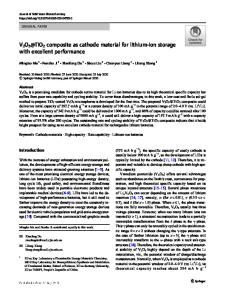Structural Phase Transformations in V 2 O 5 Thin Film Cathode Material for Li Rechargeable Batteries
- PDF / 368,849 Bytes
- 6 Pages / 414.72 x 648 pts Page_size
- 87 Downloads / 396 Views
STRUCTURAL PHASE TRANSFORMATIONS IN V2 0 5 THIN FILM CATHODE MATERIAL FOR Li RECHARGEABLE BATTERIES J.M. MCGRAW*, J.D. PERKINS**, J.-G. ZHANG**, P.A. PARILLA**, T.F. CISZEK**, M.L. FU***, D.M. TRICKETT*, J.A. TURNER**, and D.S. GINLEY** *Colorado School of Mines, Golden, CO, USA "**National Renewable Energy Laboratory, Golden, CO, USA ***University of Colorado, Boulder, CO, USA ABSTRACT We report on investigations of V20 5 thin film cathodes prepared by pulsed laser deposition and the phase transformations which occur during electrochemical cycling. Our experimental results on PLD-grown, textured V20 5 crystalline films concur with reports in the literature that there is a voltage threshold above which, cycling appears to be completely reversible and below which, cycling appears to be irreversible. Crystalline films discharged beyond the threshold to 2.0 V vs. Li exhibited an immediate and continuous fade in capacity as well as a -90% decrease in XRD peak intensity and a similar decrease in Raman signal intensity in as few as 10 cycles. We have made oophase material by both electrochemically discharging virgin, crystalline V 20 5 and by further discharging previously cycled films which showed irreversible structural changes. INTRODUCTION The high cell potentials, high power densities, and rechargeability of the bronze-forming transition-metal oxides make them very attractive candidates for cathode materials in Li rechargeable batteries. The ability to intercalate Li depends on the openness of the material structure. For crystalline material, it must be layered, channeled, or both. Electrical conductivity is also required. Assuming these fundamental requirements are met, one of the most critical parameters in evaluating materials is stability to repeated electrochemical cycling. The degree of reversibility of a discharge reaction depends upon the extent of the irreversible structural damage incurred by the host material. 1 The V 20 5 structure and the phase transformations upon lithiation 29 have been studied extensively. The open circuit voltage of V20 5 is -3.5 V vs. Li. The (x- 6- and y-LiV 20 5 phases are shown in Figure 1. The ot-Li.V 20 5 structure can be described as being made up of alternating corner- and edge-sharing VO square pyramids in a layered structure with two pyramids pointing upwards followed by two pyramids pointing downwards. The ox-LixV 20 5 phase occurs for Li intercalation of x
Data Loading...











